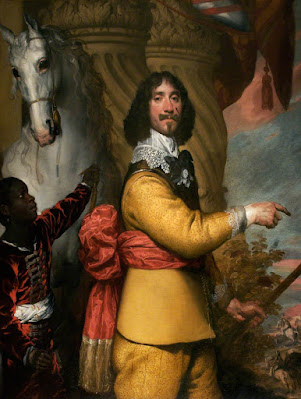 |
| Salvator Rosa Self Portrait ca. 1650-60 oil on canvas Detroit Institute of Arts |
 |
| Anonymous Lombard Artist Portrait of Suor Anna Biondi 1655 oil on canvas Palazzo d'Arco, Mantua |
 |
| Cornelius Johnson James Stanley, 7th Earl of Derby before 1651 oil on canvas Tabley House, Cheshire |
 |
| Dirk Helmbreker Self Portrait ca. 1650 drawing National Gallery of Art, Washington DC |
 |
| Isaac Fuller Portrait of Sir Thomas Baines ca. 1649 oil on canvas Christ's College, University of Cambridge |
 |
| William Dobson Portrait of John Byron, 1st Lord Byron before 1646 oil on canvas Tabley House, Cheshire |
 |
| William Dobson Portrait of architect Inigo Jones ca. 1644 oil on canvas Chiswick House, London |
 |
| Domingos Vieira Serrão Portrait of Isabel de Moura ca. 1630 oil on canvas Museu Nacional de Arte Antiga, Lisbon |
 |
| Francesco Mochi Bust of Cardinal Antonio Barberini ca. 1629 marble Toledo Museum of Art, Ohio |
 |
| Anonymous French Artist Portrait of a Young Man ca. 1620-30 oil on canvas Ashmolean Museum, Oxford |
 |
| Ottavio Leoni Portrait of sculptor Gianlorenzo Bernini 1622 engraving National Gallery of Victoria, Melbourne |
 |
| Ottavio Leoni Portrait of Cardinal Scipione Borghese ca. 1620 oil on canvas Musée Fesch, Ajaccio, Corsica |
 |
| Pietro Facchetti Portrait of a Cardinal before 1619 oil on canvas private collection |
 |
| Nicolas Lagneau Study of a Woman ca. 1600-1610 drawing Musée du Louvre |
 |
| attributed to Nicolas Lagneau Portrait of an Old Man ca. 1600-1610 drawing Musée Bonnat, Bayonne |
 |
| Anonymous Emilian Artist Portrait of a Man with a Pair of Compasses ca. 1600-1650 oil on canvas National Gallery, London |
"We approach, then, the working method for portraits. He who paints portraits is obliged to do two things – if I am not mistaken – and if he fulfills both, he is deserving of praise. The first is that the portrait appear very much like the sitter, and this is the principal end for which portraits are made, and that which satisfies the patron. Both good and bad painters are obliged to do this, and if it is not achieved, their work is for naught. The second obligation is that the portrait be well drawn, and painted in a good manner of colorido, with strength and relief. This second obligation is valued and credited among those who have appreciation of art because even if the sitter is unknown, he will yet be esteemed in regard to good painting. It sometimes happens that an ignorant and simple painter makes very good likenesses of his patrons and then they are recognized at a glance, as they achieve a rigid likeness as if cut from paper, are crudely made with such lack of art that in regard to painting, they have no value at all; and those who painted them usually are so puffed up with pride seeing their vulgar works celebrated, that they seem to lose their reason, while to those who know, these same works only give cause for laughter and amusement."
– Francesco Pacheco, from The Art of Painting (1649), translated by Zahira Veliz (1986)